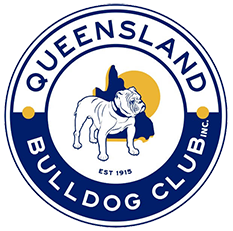
FAQs
anywhere between 10 and 14 years.
Bulldogs are regarded as Smooth coats which require the least amount of grooming, but the dog’s coat can’t be neglected. The short hair lies close to the body and needs to be brushed and bathed regularly, though not as much as some other types of fur.
Bulldogs should be finely wrinkled without excess, neither prominent nor overhanging face. Excessive wrinkle can cause skin fold dermatitis especially in warmer humid climates. Breeders should be aiming to reduce these issues. Your Bulldog should ideally have their creases cleaned on a daily basis especially if the creases are damp or discoloured, however many only require cleaning once or twice a week. Usually simply wiping the crease with a wet wipe and applying a moisture barrier such as petroleum jelly or a zinc based nappy rash cream is sufficient.
This depends on the individual dog. Like us some are high energy and others are real couch potatoes. Often your Bulldog will tailor their energy level to yours.
Bulldogs like all dogs need exercising. A daily walk is recommended starting with a short gentle walk and increasing over time to increase fitness and muscle tone. Young puppies should not be walked as their joints may be damaged, it is better to let them romp and play at their own pace. Walking or any form of exercise and play should be done in the cooler parts of the day as with any dog to avoid the risk of overheating. Daily walking helps with fitness, weight control and can provide the opportunity for good socialization and developing good manners and behavior.
his is not a necessity. If your Bulldog has been taught good manners and to walk properly on a lead then a harness is not necessary. Harnesses can also encourage dogs to pull. This is therefore a matter of personal preference.
Bulldogs are regarded as an independent breed which can make training a challenge. They can be highly intelligent and stubborn but the good news is that with different training techniques and consistency your Bulldog can be trained. There are many Bulldogs worldwide that compete in obedience, agility, scentwork and the many other varied dogsports. The most important lessons for your puppy is learning what NO means and not allowing them to do things that will be unacceptable when they are adults, no matter how cute they are.
Bulldogs often appear on internet lists for ‘best dogs for first time owners’ because they’re easy going, low-key and loving family pets. And while it’s true that Bulldogs are a lower maintenance breed in terms of exercise and temperament, it’s easy to get caught out with the other aspects of the breed that take a lot of care. This includes breed-specific medical needs, skin conditions, allergies, fold cleaning and even temperature management. These needs means that Bulldogs aren’t always an ideal first breed. However, if you have a natural ability to care and nurture and look after this breed, they’re very rewarding whether you’re a first time owner or an experienced owner.
Yes, Bulldogs do shed. Because they are short haired, it can look like they won’t shed very much. But these beautiful pups shed more than you might think. You will notice it even more when there’s a change of season and particularly coming into summer.
As with any dog, you can manage shedding with good habits. Brushing Bulldogs regularly keeps their coat in top shape and helps reduce the amount of shedding.
Bulldogs are typically great with children. They love company, they love to play and they’re very affectionate with all people – including children.
However, Bulldogs are also quite strong and built low to the ground. So it does mean that if you’ve got little ones running around, your Bulldog might not know their strength and could easily knock them over.
As with any dog, your Bulldog should be trained to be gentle with children, and to respond to your cues if they are excited and playing. If you don’t have children in your household regularly and they do come to visit, it’s a good idea to keep your Bulldog on a lead to ensure they don’t accidentally knock the child over.

While some Bulldogs have been taught how to swim, most traditionally sink like a stone… and very quickly. This is due to the way they are built – low to the ground and with a low centre of gravity. If your dog enjoys the water, you can get swim assists and water safety devices such as floaties, buoyancy vests, life jackets, floatation vests and even flotation collars which can help them keep cool without risk.Bulldogs can also learn to swim. Though they aren’t natural swimmers, they can be taught, but it takes lots of practice and lots of training. In the meantime, keep your Bulldog safe by staying in shallow water and putting a vest on them. If you are taking them swimming, or particularly if you’re taking them out on a boat, ensure they have a flotation device on them.